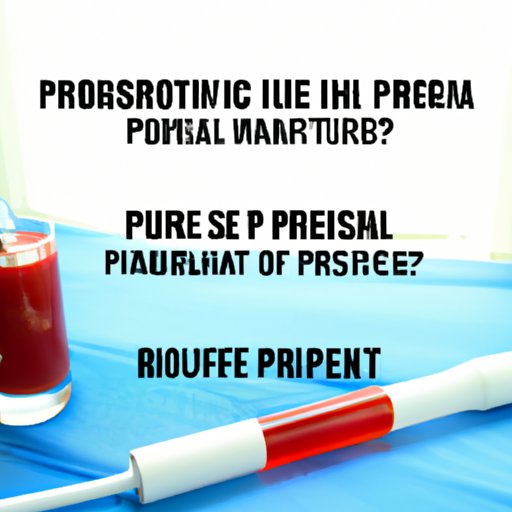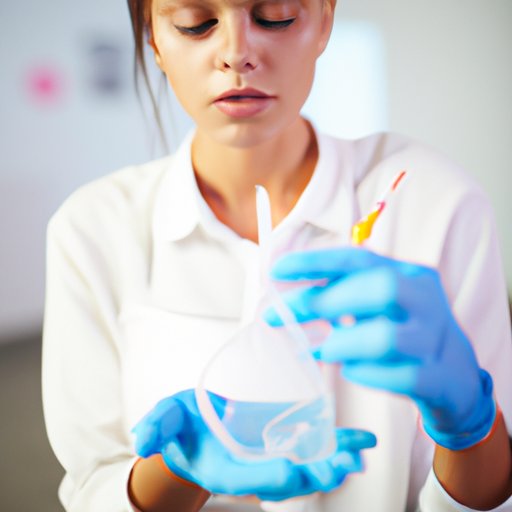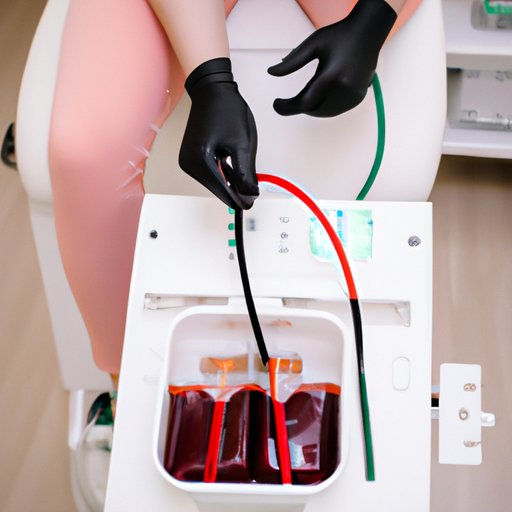Introduction
Platelet-rich plasma (PRP) is a cutting-edge medical technology that has been used for decades to accelerate the healing of various types of injuries. This article will explore the science behind PRP and explain how it works to accelerate healing. We will look at the types of injuries that can be treated with PRP, the benefits of the treatment, the research on its effectiveness, the process of preparing and administering PRP, the potential risks and complications associated with the treatment, and more.
Exploring the Science Behind PRP: How Does It Work?
PRP is a type of concentrated blood plasma that contains a higher than normal concentration of platelets. Platelets are small cell fragments that are essential for clotting and wound healing. When injected into an injured area, the high concentration of platelets helps to speed up the healing process.
The process of preparing PRP involves taking a sample of the patient’s blood and spinning it in a centrifuge to separate out the platelet-rich plasma from the other components of the blood. Once the PRP is prepared, it is then injected directly into the site of the injury. The injection of the PRP stimulates the body’s natural healing processes, which helps to reduce inflammation, promote cell regeneration, and speed up the healing process.
The use of PRP has been studied extensively in recent years and there is evidence to suggest that it can be effective in treating a wide range of injuries, including tendon and ligament injuries, muscle strains, osteoarthritis, and more. In addition, PRP has also been shown to be beneficial in speeding up the recovery process after surgery.
Using Platelet-Rich Plasma to Accelerate Healing: What You Need To Know
PRP has been used to treat a variety of injuries, including tendon and ligament injuries, muscle strains, osteoarthritis, and more. The injection of PRP directly into the site of the injury stimulates the body’s natural healing processes, which helps to reduce inflammation, promote cell regeneration, and speed up the healing process.
In addition to helping to speed up the healing process, PRP treatments have also been found to provide other benefits, such as reducing pain and improving mobility. However, the effectiveness of PRP treatments is still being researched, and more studies are needed to fully understand the potential benefits of PRP.
Unpacking the Process of PRP Therapy: A Step-by-Step Guide
The process of PRP therapy begins with a doctor taking a sample of the patient’s blood and spinning it in a centrifuge to separate the platelet-rich plasma from the other components of the blood. The PRP is then injected directly into the site of the injury. The injection of the PRP stimulates the body’s natural healing processes, which helps to reduce inflammation, promote cell regeneration, and speed up the healing process.
In addition to the injection of PRP, doctors may also recommend other treatments, such as physical therapy or medications, to help speed up the healing process. It is important to note that the effectiveness of PRP treatments may vary depending on the type and severity of the injury being treated.
Although PRP treatments are generally safe and well tolerated, there are some potential risks and complications associated with the procedure. These include infection, bleeding, and allergic reactions. It is important to discuss the potential risks and side effects of PRP treatments with your doctor before undergoing treatment.
The Benefits of PRP: What Does Research Say?
Research on the effectiveness of PRP treatments has found that PRP can be beneficial in speeding up the healing process for a variety of injuries. Studies have also shown that PRP can reduce pain and improve mobility. In addition, PRP has been found to be safe and well tolerated, with few reported side effects or complications.
However, the research on PRP is still ongoing and more studies are needed to fully understand the potential benefits of this treatment. It is important to discuss the risks and potential benefits of PRP with your doctor before undergoing treatment.

Understanding the Different Types of PRP and Their Uses
There are several different types of PRP that can be used for different types of injuries and conditions. Autologous PRP is made from the patient’s own blood and is typically used for conditions such as tendon and ligament injuries, muscle strains, and osteoarthritis. Allogeneic PRP is made from donor blood and is typically used for skin and hair regeneration.
Each type of PRP has its own advantages and disadvantages. Autologous PRP is considered to be the safest option, as it is made from the patient’s own blood and carries a lower risk of infection. Allogeneic PRP is less expensive than autologous PRP, but it carries a higher risk of infection due to the use of donor blood.

Exploring the Potential Complications of PRP Treatments
Although PRP treatments are generally safe and well tolerated, there are some potential risks and complications associated with the procedure. These include infection, bleeding, and allergic reactions. It is important to discuss the potential risks and side effects of PRP treatments with your doctor before undergoing treatment.
In addition, it is important to follow your doctor’s instructions carefully to ensure that the PRP is administered correctly. This includes avoiding activities that could put stress on the treated area and being sure to take any medications prescribed by your doctor.
Finally, it is important to note that the results of PRP treatments may vary depending on the type and severity of the injury being treated. It is important to discuss the expected outcomes of PRP treatments with your doctor before undergoing treatment.
Making Sense of PRP: An Overview for Patients
Platelet-rich plasma (PRP) is a type of concentrated blood plasma that contains a higher than normal concentration of platelets. It has been used to treat a variety of injuries, including tendon and ligament injuries, muscle strains, osteoarthritis, and more. The injection of PRP directly into the site of the injury stimulates the body’s natural healing processes, which helps to reduce inflammation, promote cell regeneration, and speed up the healing process.
The process of PRP therapy involves taking a sample of the patient’s blood and spinning it in a centrifuge to separate out the platelet-rich plasma from the other components of the blood. Once the PRP is prepared, it is then injected directly into the site of the injury. The injection of the PRP stimulates the body’s natural healing processes, which helps to reduce inflammation, promote cell regeneration, and speed up the healing process.
Research on the effectiveness of PRP treatments has found that PRP can be beneficial in speeding up the healing process for a variety of injuries. There are potential risks and side effects associated with PRP treatments, so it is important to discuss these with your doctor before undergoing treatment.
Conclusion
Platelet-rich plasma (PRP) is a cutting-edge medical technology that has been used for decades to accelerate the healing of various types of injuries. This article has explored the science behind PRP and explained how it works to accelerate healing. We have looked at the types of injuries that can be treated with PRP, the benefits of the treatment, the research on its effectiveness, the process of preparing and administering PRP, the potential risks and complications associated with the treatment, and more.
It is important to discuss the potential risks and benefits of PRP treatments with your doctor before undergoing treatment. For more information on PRP and its uses, readers should consult their healthcare provider or do further research.
(Note: Is this article not meeting your expectations? Do you have knowledge or insights to share? Unlock new opportunities and expand your reach by joining our authors team. Click Registration to join us and share your expertise with our readers.)
